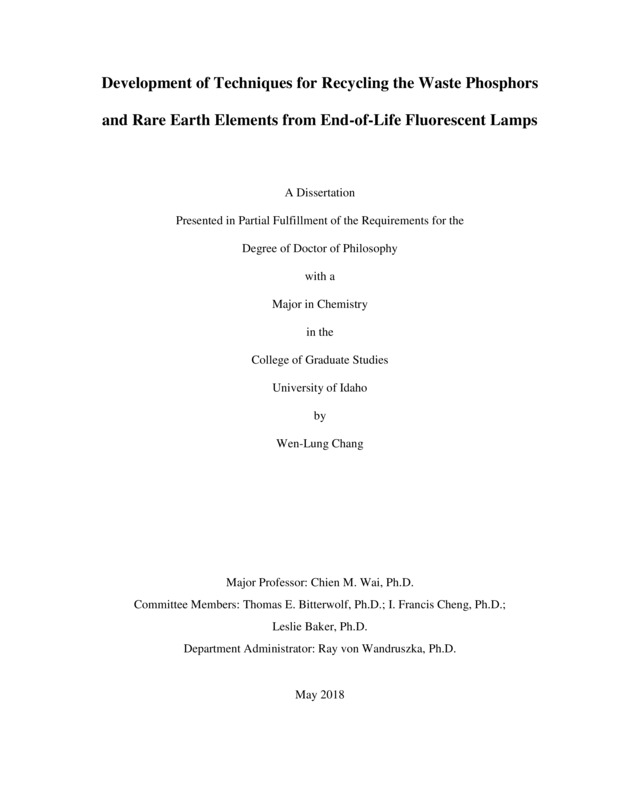Development of Techniques for Recycling the Waste Phosphors and Rare Earth Elements from End-of-Life Fluorescent Lamps
Chang, Wen-Lung. (2017-12). Development of Techniques for Recycling the Waste Phosphors and Rare Earth Elements from End-of-Life Fluorescent Lamps. Theses and Dissertations Collection, University of Idaho Library Digital Collections. https://www.lib.uidaho.edu/digital/etd/items/chang_idaho_0089e_11281.html
- Title:
- Development of Techniques for Recycling the Waste Phosphors and Rare Earth Elements from End-of-Life Fluorescent Lamps
- Author:
- Chang, Wen-Lung
- ORCID:
- 0000-0002-7280-0811
- Date:
- 2017-12
- Embargo Remove Date:
- 2021-03-28
- Program:
- Chemistry
- Subject Category:
- Analytical chemistry
- Abstract:
-
Rare earth elements (REEs), the vitamins for modern societies, have been considered some of the most critical elements. They are essential in various industrial applications. With rapid growth in the consumption of rare earths due to the development of new clean energy and defense-related technologies, the demand for these elements have become higher and higher. However, opening a new mine is an expensive, time-intensive process. As a result, reclaiming the rare earth metals from REE-containing end-of-life electronics has become one approach of reducing US dependence on import of these critical materials.
The phosphor material used in fluorescent lighting, containing rare earth elements such as cerium, europium, lanthanum, terbium and yttrium, is one of the most accessible sources of REEs in our daily life. Annually, over 680 million fluorescent lamps are reportedly disposed of in the United States. It not only increases the environmental burden, but is also a big waste of valuable rare earth elements. Therefore, developing innovative technologies of recycling REEs from end-of-life fluorescent lamps has become critical.
In fluorescent lamps, mercury is used to generate UV light with a wavelength of 254 nm, which in turn excites the phosphors to produce visible light. Mercury is highly toxic and listed as a hazardous substance by the USEPA. To reuse or reclaim spent rare earth phosphors, the first step is to remove mercury from them. The traditional ways for removing mercury from phosphors are either time-consuming or energy-intensive. By using a NaCl/NaOCl solution with the assistance of ultrasound, the mercury level in the spent phosphors can be reduced rapidly in a few minutes and meet the USEPA standards for universal non-hazardous wastes.
The rare earth elements in the fluorescent phosphors exist in various chemical forms. Typically, europium and yttrium are in oxide forms; cerium, lanthanum and terbium are doped in phosphate or aluminate matrices. Rare earth oxides are soluble in acids, and therefore, the europium and yttrium in spent fluorescent phosphors can be easily extracted by acids. However, phosphate and aluminate matrices are more chemically stable. As a result, extracting cerium, lanthanum and terbium from the phosphors requires a pretreatment procedure. By pretreating the phosphors with sodium peroxide at 650 oC, cerium, lanthanum and terbium in the treated phosphors become extractable by supercritical fluid carbon dioxide (sc-CO2). The extraction efficiencies for cerium, lanthanum and terbium are over 96% using a tri-n-butylphosphate-HNO3 extractant in sc-CO2.
With the assistance of ultrasound, direct extraction of the REEs from the phosphors by nitric acid at elevated temperature is also possible. For example, with nitric acid of 11M at 80°C under sonication for 1 hour over 99% of cerium, europium, lanthanum and yttrium as well as 93% of terbium could be extracted from the fluorescent phosphors.
- Description:
- doctoral, Ph.D., Chemistry -- University of Idaho - College of Graduate Studies, 2017-12
- Major Professor:
- Wai, Chien
- Committee:
- Bitterwolf, Thomas E.; Cheng, I. Francis; Baker, Leslie
- Defense Date:
- 2017-12
- Identifier:
- Chang_idaho_0089E_11281
- Type:
- Text
- Format Original:
- Format:
- application/pdf
- Rights:
- In Copyright - Educational Use Permitted. For more information, please contact University of Idaho Library Special Collections and Archives Department at libspec@uidaho.edu.
- Standardized Rights:
- http://rightsstatements.org/vocab/InC-EDU/1.0/

